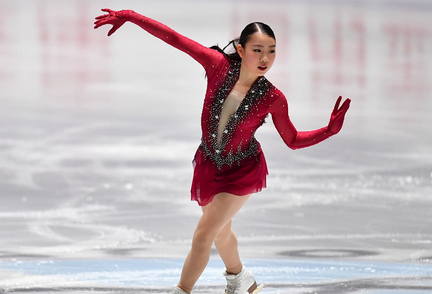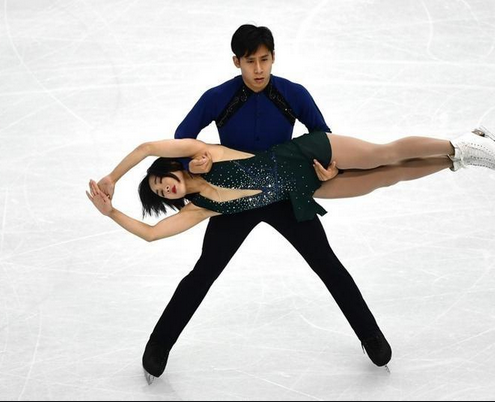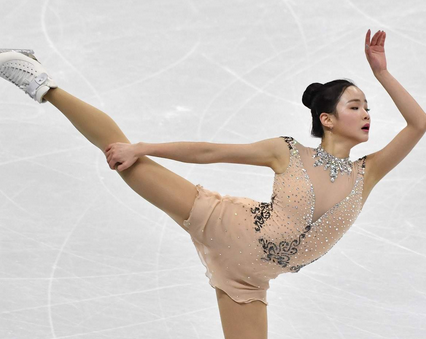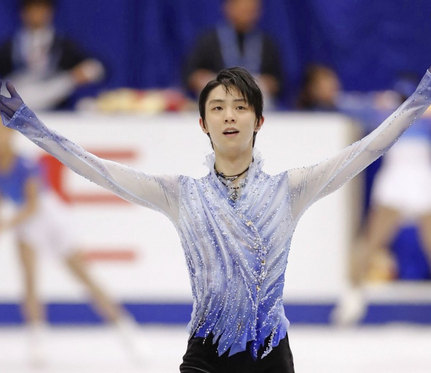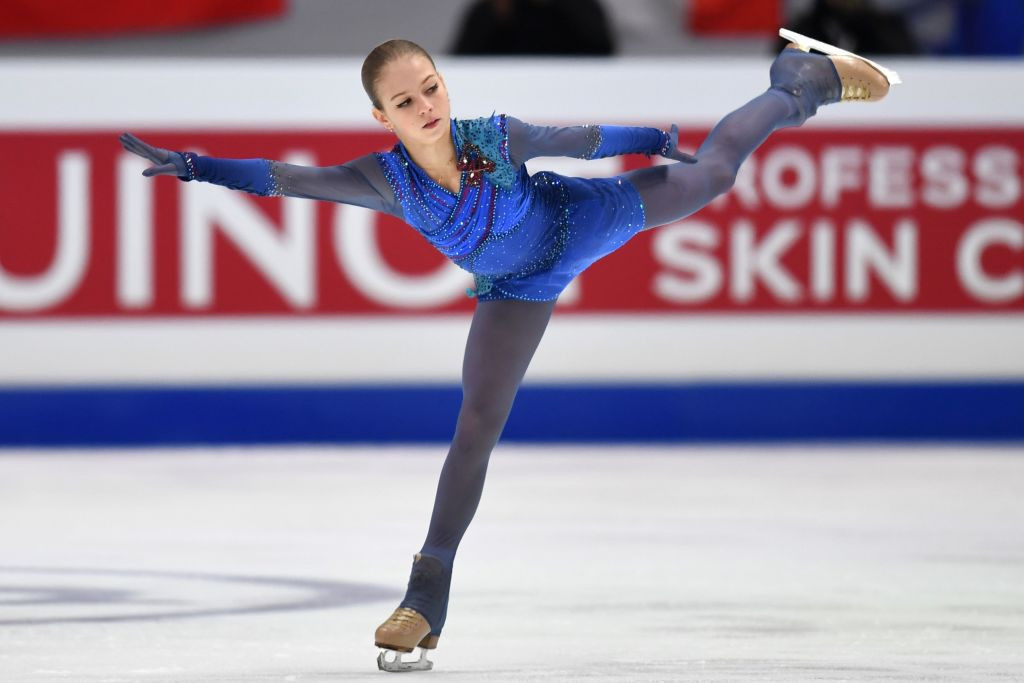the fashion trends of figure skating costumes in the 21st century: a thread
1998: michelle kwan wins the silver medal in nagano with her sleek velvet costume with tank-top straps ushers in a new era of more skintight, athletic costumes compared to the heavier and elaborate dress costumes as seen below on the 1994 olympic podium
2004: the international skating union decrees that female skaters can wear pants (except for ice dancers), leading to bodysuits worn by irina slutskaya (2005) sarah meier (2006) and in then 2018 being brought back by carolina kostner and mae berenice-meite
2006: ice dancer Tanith Belbin's costume leads to the isu declaring that 40% of a skater's body most be covered in an extension of the katarina rule, which mandated skirts for female skaters in 1988. belbin's iconic silhouette has inspired many dancers' costumes to this day
2006: Japanese singles skater Shizuka Arakawa wins the olympic gold medal this year in her kimono-inspired costume, creating the trend of kimono-style skating costumes seen here worn by mao asada (2016), satoko miyhara (2018), and evgenia medeveda (2019)
2006: completion of the first olympic quad in 2000s is complete, and the current fs costume trends reflect the eclectic, bright, and textured style of this y2k era. this is the peak of the elaborate costumes in skating, fabric volume will decrease but the bright colors remain
2007: singles skater Yuna Kim and ice dancers Virtue/Moir enter seniors and bring with them classic silhouettes and elegant designs into fashion, settings trends of simple silhouettes and elegant detailing setting the standard in the next eight years of their careers.
2012: ice dance costumes have fully moved away from the shredded, voluminous style which was maintained until 2010 by ice dancers Domnina/Shabalin. however, as a retro style it's recently made a comeback in 2019 with singles skater Alexandra Trusova.
2013: pairs skater Aljona Savchenko wears her iconic bright pink bodysuit for her "Pink Panther" program, inspiring a generation of pairs skaters to favor sleek, bold, and athletic bodysuits that had since fallen out of style since 2006.
2014: ladies singles costumes trends at the sochi olympics favor classical styles with one darker color or several in the same family, a drastic departure from the favored trends at the vancover olympics that featured costumes with bright colors, textures, and shapes
2015: long sleeves have always been favored by men, but more now women in all disciplines elect for costumes with long sleeves being implemented into their dresses being led by Elizaveta Tuktamysheva’s signature gauze sleeve dresses as she won the world championship that year.
2015: Satoko Mihyara's free program costume this year features a design of beaded curves, which she herself returns to in 2019, as well being an element as used by Elizabet Tursynbaeva this year
2016: ice dancers Papadakis/Cizeron rise in the ranks with costumes that featured long skirts, gauzy fabric to generate flowy movement, and gentle ombre patterns. in ice dance, this was immediately implemented as a major trend and still exists in 2021.
2016: Mao Asada's deep curved v-neck style seen below in her short program costume this year has became a popular design piece for ladies singles skaters, as seen below in Alysa Liu (2019), Karen Chen (2018), and Daria Uschova (2020)
2017: In ice dance, the the isu allowed ice dancers to wear pants for the first time due to the hip-hop/swing rhythm with the midnight blues pattern short dance. Seen below are the pants and bodysuit styles worn by Tessa Virtue, Madison Hubbell, Maia Shibutani, and Madison Chock
2017: Swedish designer lisa mckinnon enters the figure skating costume world, designing for Ashley Wagner and Karen Chen this year. In 2018 to present she's designed for the Shibutanis in dance, Savchenko/Massot and the Kirnems in pairs as well as Mariah Bell and Eunsoo Lim
2017: McKinnon’s signature style of classic silhouettes for skaters combined with the showmanship and details of her earlier costume work in show skating creates a modern twist on the costume styles of the past (with lots of crystals) can be seen in Rika Kihara and Sui/Han
2017: After a decade of moving towards streamlined costumes with paired-down details, ladies singles skaters have moved back to the intricacy and eclecticness of the 2000 through animal designs seen in Karen Chen (2017) Mai Maihara (2020) and Kamila Valieva (2019, 2020)
2018: Canadian designer Mathieu Caron's iconic 2018 Moulin Rouge costumes for Virtue/Moir make a mictrotrend in high-collars and the “Tessa Virtue” silhouette for girls’ costumes, and mesh in mens’ costumes, seen in Carriera Pomereko(2019), Lajoie/Lagha (2019) & Eunsoo Lim(2020)
2018: Olga Ryabenko, costume designer for all of Eteri Tutberidze’s students, evolved her own style this year into one with intricate appliqués, sequins, and crystals upon layers of fabric, seen in Evgenia Medeveda, Alexandra Trusova, Aliona Kostronaia, and Alina Zagitova
2018: Vera Wang’s monochromatic abstract works for Nathan Chen at the 2018 olympics inspire a movement for ultra-paired down costumes in the mens disiplie, but Wang's impact can seen below in singles skater Stephen Goglev and pairs Tarasova and Morozov.
2018: However, Satomi Ito’s costumes for singles skaters Yuzuru Hanyu in particular do not follow this trend towards minimalist mens costumes, but rather goes in the opposite direction with lots of lightweight fabric and crystals to make costumes that seem like pieces of art.
2019: Ryabenko’s current signature style of heavy use of appliqués in her clients extends to other disciplines and countries, seen seen pairs skater Ashley Cain, and singles skaters Kaori Sakaomoto.
2019: Ryabenko this year favors a more sculptural style (somewhat like Ito) by using lots of fabric to create heavy, solid shapes, as well as giving the bodice on Medeveda's 2018 costumes to more skaters, seen in Kamila Valieva (2020) and Alena Kostornaia (2018)
2020: Looking at the picture of the 2015 worlds podium to now, mens costumes have become much more simple, athletic, and monochromatic in the last five years, echoing the current mentality of athleticism in mens skating. details have been paired down and color schemes darker
end of thread! thanks so much for reading, i'm not any kind of fashion expert, just someone who noticed a lot of fashion trends and fs and wanted to share. nothing to promote but myself, you should all follow me i talk about figure skating, tv, and movies :)

 Read on Twitter
Read on Twitter



















































